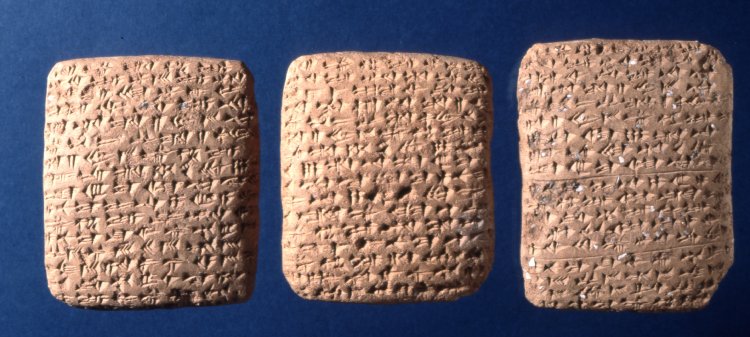The specific purpose and intent of this entry is to present research on biblical synchronisms; references to the same or supposedly same historical events from multiple cultures. Literature that falls in the category of mythical will not be covered even though there is a large amount of biblical and Akkadian literature that refers to the same events, such as creation and flood events.
Information will be sectioned off into multiple posts, organized by date ranges. This is the first entry which will cover the Kassite period (1600-1160 BCE).
Kassite Period (1600-1160 BCE)
The texts from the Kassite Period (1600-1160 BCE) start to overlap with the biblical texts of the Old Testament because at this point most nations already had developed a written language and new technologies allowed for communications to now be written down and passed along to others.
During the time of the Canaanite conquest the most profound source of extra-biblical evidence is from a cache of letters called the Amarna letters. The Amarna letters, which were mostly written in the early to mid-13th century BCE, capture communication back and forth from Egyptian Ruler Amenophis III and his various loyal vassal-governors in the land of Canaan. One interesting aspect of these letters is that they are written in Akkadian cuneiform and not Egyptian. This time period is the same time period we read about in Joshua and Judges (though, some scholars disagree on the exodus timing).
Amarna Letters: Conditions in The Promised Land
The opening of Joshua, chapter 10, describes the King of Jerusalem being afraid because of the capturing of Ai and Jericho by Joshua during battle. There is a striking parallel in the #287 and #290 Amarna letters referring to Abdi-Heba of Jerusalem. The king at the time of Joshua’s invasion was Adoni-zedek (Joshua 10:1-3), which would have had to come after Abdi-Heba since Joshua overtook southern and northern Palestine (Joshua 10-11). From the letters of Adbi-Heba it is clearly seen that he is having severe trouble with the Apiru. This is depicted in letters #287 and his sixth letter, #290. The sixth letter is the last and most severe letter and the Abdi-zedek begs once again for military help by means of archers from Egypt. Nearing the end of the letter, the king states that if no archers are sent, then Jerusalem will fall to the Hapiru (same as Apiru).
The texts are unclear about who the Apiru/Hapiru/Habiru people are. There is only soft evidence about whether or not the Habiru are actually the Hebrews.  According to other ancient texts found concerning the Habiru, they were found to live all along the fertile crescent in the 2nd millennium BCE. In the time of Old Babylonia they were hired mercenaries for the state and also formed bands of outlaw rebels against the state.
According to other ancient texts found concerning the Habiru, they were found to live all along the fertile crescent in the 2nd millennium BCE. In the time of Old Babylonia they were hired mercenaries for the state and also formed bands of outlaw rebels against the state.
Given that their existence was before Joshua and the Canaan conquest, it is difficult to label these rebels as Hebrews specifically from Egypt. It is possible that the Habiru in the Amarna Letters are a mix of Hebrews from Egypt and also local rebels from the previous Hebrew peoples, like Abraham was. Remember that Hebrews existed before the Egyptian captivity. Either way, the Amarna texts (#287-290) give an excellent insight into the turmoil that was going on around the same time that Joshua marched into the land. It is likely that the already troublesome environment of the land assisted the Israelites in their task of taking over the land.
Amarna Letters: Cultural Connections
While it is hard sometimes to match particular events from the Amarna letters to exact biblical events from this time period, it is not hard to see that the land and culture in question is the same. The detestable worship of Baals and sun/moon gods is documented even within the circumstantial Amarna Letters. Recall that in the first five books of the Bible idolatry was a major issue.
And when you look up to the sky and see the sun, the moon and the stars–all the heavenly array–do not be enticed into bowing down to them and worshiping things the LORD your God has apportioned to all the nations under heaven. (Deuteronomy 4:19 NIV)
Joshua said to all the people, “This is what the LORD, the God of Israel, says: ‘Long ago your ancestors, including Terah the father of Abraham and Nahor, lived beyond the Euphrates River and worshiped other gods. (Joshua 24:2 NIV)
So because Gideon broke down Baal’s altar, they gave him the name Jerub-Baal that day, saying, “Let Baal contend with him.” (Judges 6:32 NIV)
You must not worship the LORD your God in their way, because in worshiping their gods, they do all kinds of detestable things the LORD hates. They even burn their sons and daughters in the fire as sacrifices to their gods. (Deuteronomy 12:31 NIV)
In letter #108, Rib-Hadda gives praises to Baal and also Samas in the sky. In the 207th letter Ipte praises Baal of the sun, for delivering him in battle against the Apiru. In tablet #149, Abi-Milku praises Pharaoh and compares him to Sun god. There are numerous accounts in both Akkadian and Canaanite literature that speak of the religious nature of the area, which affirms the biblical accounts. Judges 8:33 records that after Gideon died, the Israelites turned from the Lord and worshiped Baals and made Baal-berith their God. This should come at no surprise given the nature of god/goddess worship within the land.
Israel Mentioned in Egyptian Inscriptions
While the period of enslavement by the Egyptians meant that the Israelites would certainly not be writing anything down, it did not prevent the Egyptians from documenting certain things. A stele (monument) from Egypt, dating back to 1208 BCE is the firs known inscription mentioning the nation of Israel. It was discovered in 1896 and is stored in the Cairo Museum currently. The monument mostly speaks of military victories over Egypt’s enemies. 3 of the lines in the inscription refer to Canaanite lands/peoples.
The Canaan has been plundered into every sort of woe:
Ashkelon has been overcome;
Gezer has been captured;
Yano’am is made non-existent.
Israel is laid waste and his seed is not;
Israel is also mentioned in the base of a statue from Egypt. This discovery was made by the same archaeologist (Ludwig Borchardt) that discovered the Nefertiti bust and helped excavate the Amarna region. The inscription is believed to be between 1400 – 1200 BCE, right around the time where Israel was in captivity or shortly after leaving captivity.
This relief shows 3 different people’s essentially having Egyptian rule placed over them. The third people group is thought be Israel. In the image below the reasoning behind the test is show.
Unfortunately, it is not certain whether or not this is a clear reference to Israel. The Journal of Ancient Egyptian Interconnections makes a very strong argument that it is not representing Israel but the field is quite divided on this piece.
Final Thoughts
More could be said about archaeology and the conquest of Canaan but for the sake of this post I will not include everything. It is important to know that many of the cities of Canaan that were mentioned in the Bible have now undergone excavations. The findings of those digs can be found HERE.
Comments, thoughts, and corrections welcome below.





A general or Prince called Tuthmoses (later just Moses) whose adopted mother named him after herself, Ahmose was Pharoah of Egypt with his adopted mother mother for a time and may have even been Pharoah by himself as Ahmose I. Ahmose II was most likely the Pharoah of the Exodus. But, don’t take my word for all of that. Read Ahmose I’s stelae and read Ahmose II’s stelas the second stelae abruptly ends only halfway through at the Red Sea after chasing a race of people through what sounds exactly like the Exodus route. His body was never found and also coincidentally there was no chariots available for other wars for quite a while after that.
I read the Bible four times as a child I thought I believed different from everyone else. For a time I said I was an atheist. Because I thought I believe so different from everyone else.
The first person that came close was Thomas Edison and I thought wow I’m a genius. But a Bible verse got me back to reading the Bible again. And I realized all my beliefs like what Edison believed came from the Bible.
But how can people not see Ahmose named her son Ahmose because she pulled him from the water. It was written plain as day in the Egyptian language. Ramose was her father. She was the pharaoh’s daughter that pulled Moses from the water.
Iggy, your theory is not an uncommon one. I cannot say that I am convinced by it but there are some real pieces of evidence to support it. However, I don’t think that Ahmose II’s stele tells the story. It’s about events 700-1000 years later. Ahmose ruled in the 6th century BCE. His stele tells of a civil war of sorts and is backed by later Greek sources.
As for the meaning of Ahmose, I am no Egyptologist but I am fairly certain that his name means born of Iah (the moond god).
The cities of Ashkelon and Gezer were Philistine territory that weren’t fully conquered by Israel. Yanoam, is not known (maybe Yaknoam).
According to the accounts in Genesis, and the dates that follow throughout the entirety of the era of Kings and Judges, the Exodus occurred in 1312bce, which is 2448 years from the creation of Adam. Moses birth was 80 years before the Exodus in 1392bce or 2528 from Adam. Abraham was born in 1912bce, or 1948 from Adam, when Noah was 58 years old His son Shem was Malchitzedek, and Shem’s daughter was Tamar who became the mother Judah’s twin sons (Peretz and Zarach). Isaac was 100 years later in 2048bce, or 2048 from Adam. And the flood was in 1656 from Adam.
The letters M-S in ancient Egyptian mean ‘to come from’. Thus Rameses means ‘to come from Ra’ and Mosa would be incomplete, and as it says in Exodus ‘he was drawn from the water’.
Since the word Hebrew is a poor transliteration of the word Ivri (pronounced ihv`ree) it is a stretch to say that the word Apiru or Habiru is from the same source.